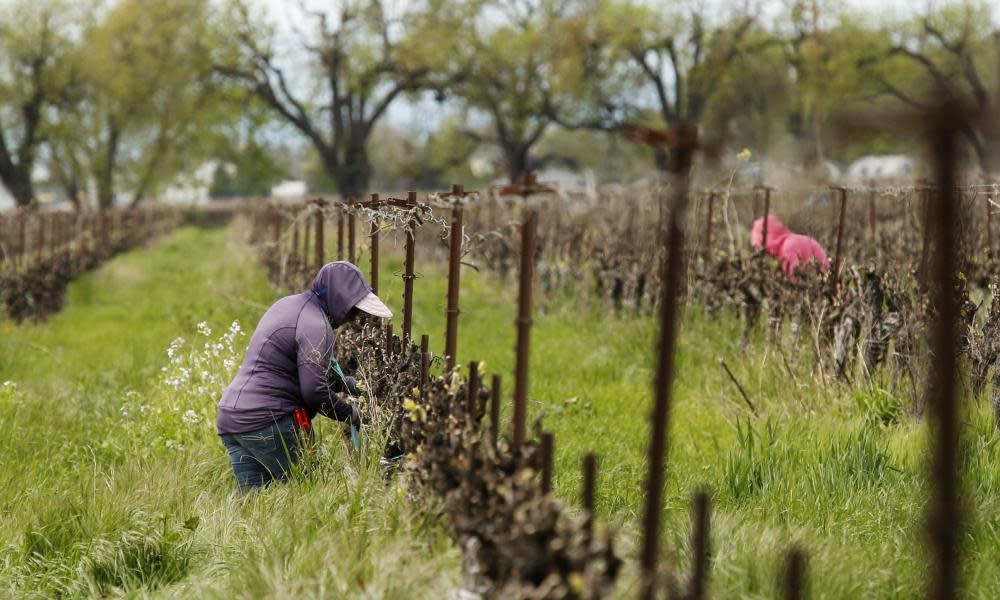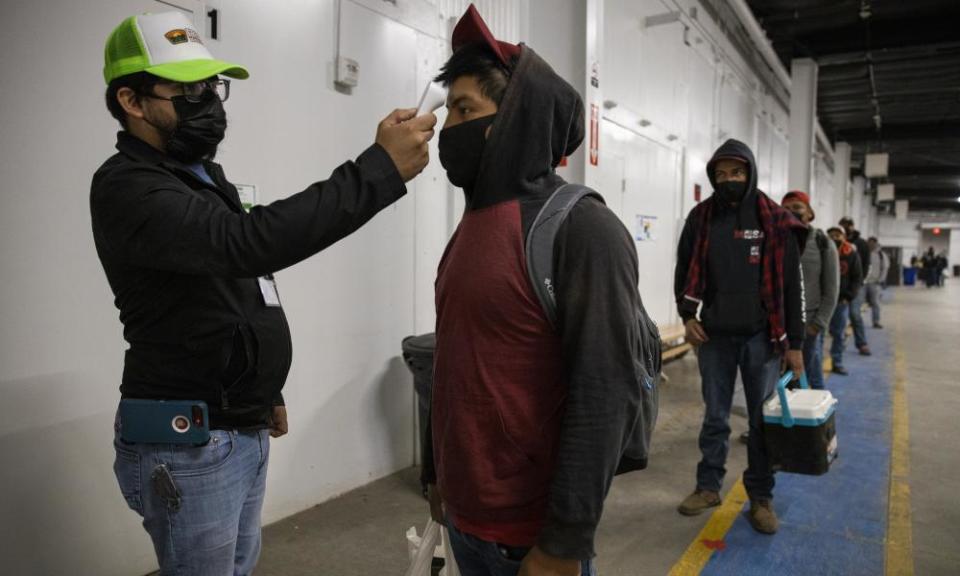Covid and California's farmworkers: study lays bare disproportionate risks

California’s agricultural workers have contracted Covid-19 at nearly three times the rate of other residents in the state, a new study has found, laying bare the risks facing those who keep a $50bn industry afloat.
Farmworkers have been deemed “essential” and thus continued to work throughout the duration of the pandemic. Epidemiologists already knew that this primarily Latino workforce was disproportionately affected by the virus, with Latino individuals experiencing five to seven times the risk of Covid-19 mortality relative to white individuals in the US.
But a study from the University of California, Berkeley, published Wednesday, is the first to explore the prevalence of infection rates among the workforce putting food on tables across America.
Related: 'This is a war': the coronavirus disaster in California's hardest-hit – and poorest – county
The study surveyed 1,091 farmworkers from mid-July through the end of November in the Salinas Valley, home to more than 50,000 agricultural workers. Key findings include that 13% of these workers tested over this five-month period tested positive. Comparatively, just 5% of all Californians tested came back positive. The study also found that one in five of the workers tested were antibody positive, meaning they had been infected some time before.
Of the positive cases among the farmworkers, 45% of those cases were asymptomatic. The study found that 57% of workers who reported experiencing symptoms and 58% who had symptoms and later tested positive had continued working when they had symptoms.
“One of the main takeaways from this study is that the Latino population is not just disproportionately affected by high positivity rates, but they’re also affected in the sense that they’re vulnerable because a lot of them are going to work when sick because they’re worried about losing their jobs and losing their pay,” said the principle investigator Ana Maria Mora, an assistant researcher at the UC Berkeley Center for Environmental Research and Children’s Health. “More than half of the farmworkers we surveyed, their annual household income is less than $25,000. A lot of them are food insecure. They’re bringing food to our table but many can’t provide food for their families.”

And in continuing working, they are furthering the spread. Given that 37% lived in overcrowded households, often with multiple families in one house or one apartment, 35% commuted with non-household members and 53% came within six feet of others during a shift, the risk is high.
In April, Gavin Newsom, California’s governor, signed an executive order providing two weeks of paid sick leave for food sector workers subject to a quarantine order. He signed a bill in September ensuring two weeks of paid sick leave for every Californian worker. But the study found that many of its subjects were unaware of the options available to them.
“We’re still getting reports from workers talking about how they’re not being advised of co-workers being infected, and they’re not being offered sick days, when they should,” said Armando Elenes, the secretary-treasurer of the United Farm Workers of America. “Farmworkers are still not being informed of their rights.”
Brenda Eskenazi, the director of the Center for Environmental Research and Children’s Health, and Mora believe there need to be education campaigns specific to farmworkers. “A lot of the education campaigns are just about how it’s not a hoax, wear a mask,” Eskenazi said. “They don’t go to the next step of, ‘if you’re sick, if you’ve been tested and test positive, this is what you do. We can help you.’ Or, ‘if you’re sick, we can help you fill out forms to get replacement income. Or, ‘‘if you’re undocumented, you don’t have to worry we’ll turn you in.’”
We need to keep them healthy, to keep the industry healthy, to keep our food supply healthy
Brenda Eskenazi
The education campaign must go beyond Spanish or English. The study found that workers who spoke only an Indigenous language had higher positivity rates – 23% – than those who spoke only Spanish (12%), and those who could speak English (4%).
With the amount of mistrust this population has of the government, Eskenazi and Mora felt that any outreach or testing would be more successful if done directly in the fields or in the neighborhoods where workers live.
And while the study found that the workers’ employers in Salinas Valley have done fairly well in providing hand-washing stations, hand sanitizer and face coverings, Eskenazi and Mora recommended that local authorities prioritize rapid testing of farmworkers. “The reason why it’s really essential is because at the same moment you get the results, you can do contact tracing and wraparound services to get that person out of communal housing and into services,” Eskenazi said. “Once that person leaves that site and doesn’t get the result for two days later, the likelihood is that person is back in their home and infecting others.”
The study began exploring workers’ attitudes toward a vaccine, and the principle investigators found the results concerning. Almost half the study participants said they were either unsure or unlikely to get a vaccine, with that same mistrust of the government fueling fears. Eskenazi said it was important to start preparing for this for when the vaccine becomes available.
“We want to make sure that the farmworkers are made a priority. We want to protect the farmworkers. But beyond that, we want to protect our food supply,” Eskenazi said. “We need to keep them healthy, to keep the industry healthy, to keep our food supply healthy. It’s for food security, for all of us, not just those living in California. We need to prioritize the farmworkers, for their sake and ours as well. It’s for all of us.”

